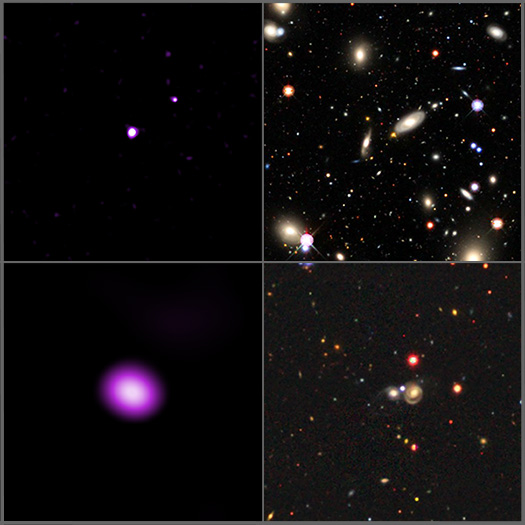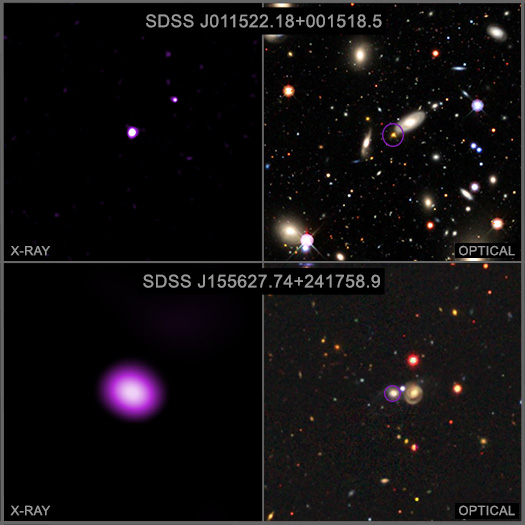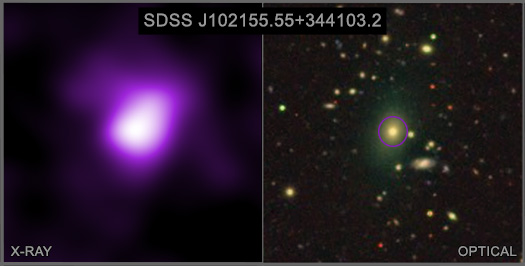Astronomers Dig Out Buried Black Holes With NASA's Chandra

SDSS J011522.18+001518.5 and SDSS J155627.74+241758.9
Credit: X-ray: NASA/CXC/SAO/D. Kim et al.; Optical/IR: Legacy Surveys/D. Lang (Perimeter Institute)
This panel of images represents a survey that used data from NASA’s Chandra X-ray Observatory to uncover hundreds of previously “hidden” black holes. This result helps astronomers conduct a more accurate census of supermassive black holes that exist in the centers of most large galaxies, as reported in our latest press release.
This graphic shows two of the galaxies from the new study, with Chandra X-ray data in purple and optical data from the Sloan Digital Sky Survey (SDSS) in red, green and blue. These black holes were found in galaxies that are dim in optical light, but bright in X-rays. Astronomers have dubbed these “XBONGs” (for X-ray bright, optically normal galaxies). While scientists have been aware of XBONGs for several decades, an explanation for their unusual properties has been unclear.

(Credit: X-ray: NASA/CXC/SAO/D. Kim et al.; Optical/IR: Legacy Surveys/D. Lang (Perimeter Institute))
The team made this advance by comparing data from the Chandra Source Catalog — an online public repository of data from the mission’s first 15 years — with those from SDSS. Chandra’s sharp images, matching the quality of those from SDSS, and the large amount of data in the Chandra Source Catalog made it possible for the researchers to detect 817 XBONG candidates — more than ten times the number known before Chandra was in operation. Further study revealed that about half of these XBONGs represent a population of previously-hidden black holes.
The black holes in this study belong to the “supermassive” category, meaning they contain millions or even billions of times the mass of the Sun. Their presence can be revealed by radiation from material they are actively pulling in as they grow, but some of these black holes are enshrouded by material that blocks most light from escaping. X-rays are particularly useful to search for rapidly growing black holes because material swirling around them is superheated to millions of degrees that glow strongly in X-ray wavelengths. A thick cocoon of gas and dust surrounding a black hole will block most or all the light at optical wavelengths. X-rays, however, pass through the cocoon much more easily to be detected by Chandra.
The X-ray sources in this new study are so bright that almost all of them must be from material surrounding rapidly growing supermassive black holes. Data from NASA's Wide-Field Infrared Survey Explorer provides additional evidence that about half of the XBONGs are buried, growing supermassive black holes. These black holes range in distances between 550 million and 7.8 billion light-years from Earth.

(Credit: X-ray: NASA/CXC/SAO/D. Kim et al.; Optical/IR: Legacy Surveys/D. Lang (Perimeter Institute))
These results were presented by Dong-Woo Kim of the Center for Astrophysics | Harvard & Smithsonian at the 241st meeting of the American Astronomical Society in Seattle, WA. Other members of the research team included Amanda Malnati, an undergraduate at Smith College, and Alyssa Cassidy, a graduate student at the University of British Columbia.
Please note this is a moderated blog. No pornography, spam, profanity or discriminatory remarks are allowed. No personal attacks are allowed. Users should stay on topic to keep it relevant for the readers.
Read the privacy statement
